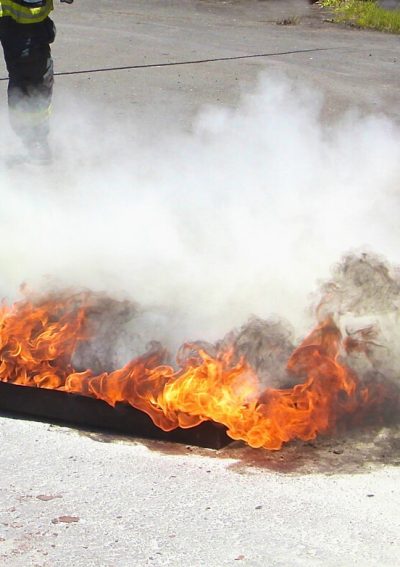PFAS in Firefighting Foam
Per- and polyfluoroalkyl substances are added to firefighting foam to help extinguish liquid fuel fires. PFAS can persist in the environment and accumulate in the body, potentially causing serious health effects. State and federal legislators are proposing and enacting PFAS restrictions.

Are PFAS in Firefighting Foam?
Many firefighting foams still contain per- and polyfluoroalkyl substances, though fluorine-free foams are available. The most common form of these is aqueous film-forming foams. Manufacturers specifically infuse these additives into foams because they can effectively help to extinguish liquid fuel fires.
PFAS chemicals are an environmental and public health hazard. They can persist in the environment for years, with certain PFAS chemicals persisting for decades. PFAS exposure risk continues long after firefighters extinguish the fire.
“Per- and poly-fluoroalkyl substances (PFAS) have been used in aqueous film-forming foams (AFFFs) for fighting liquid fuel fires since the 1970s.”
Local fire departments across the U.S. have used PFAS-based firefighting foam for more than 50 years. Though some states or municipalities restrict their use, many localities still maintain an inventory of the foam and would use it under certain circumstances. The military, firefighter training facilities and airports routinely use PFAS firefighting foam.
The military’s routine and extensive use dates at least as far back as 1963, when the Navy applied for a patent for adding PFAS chemical to firefighting foam. Despite state and municipal restrictions, PFAS foam application continues. For example, NC Newsline reported in April 2023 that state data showed North Carolina fire departments had put out 51 fires using PFAS-containing firefighting foam and had more than 120,000 gallons of it on hand.
PFAS Foam vs. PFAS-Free Foam
Many fire departments are transitioning to the use of PFAS-free foam or fluorine-free foam. In January 2023, the U.S. Department of Defense announced plans to phase out PFAS chemicals in firefighting foam. The timeline for moving to fluorine-free foam depends on finding an alternative that effectively extinguishes class B hydrocarbon liquid fuel fires.
Both PFAS and PFAS-free foams are synthetic materials and contain solvents. Fluorine-free foam, however, doesn’t bioaccumulate.
- Fluorine-free foam contains chemicals other than PFAS.
- PFAS bioaccumulate, are toxic to the environment and are a human health hazard.
- Fluorine-free foam breaks down more easily than PFAS, which can persist in the environment for years.
- PFAS foam forms an aqueous film that suppresses liquid fuel fires.
- Fluorine-free foams don’t form an aqueous film to extinguish fires. Instead, they rely on a blanket of bubbles to smother the flames.
While PFAS are effective for extinguishing liquid fuel fires, research suggests that PFAS are associated with detrimental impacts on human and animal health. PFAS contamination causes long-term environmental toxicity.
Who Is at Risk of PFAS Exposure From Firefighting Foam?
Anyone working with PFAS firefighting foam or in an area where firefighters have used PFAS foam is at risk of exposure. Though firefighters are most vulnerable to direct exposure to toxic chemicals, the PFAS in firefighting foam can contaminate the environment when discharged during training, system testing or liquid-fuel fire incidents. Accidental discharges can also occur.
After discharge, PFAS firefighting foam seeps into the ground or runs off into nearby water sources, leading to PFAS-contaminated water and soil. Contaminants in the soil can then percolate into groundwater systems used to supply drinking water. When the chemicals leach into soils used to plant crops, plants may absorb them, leading to PFAS in the food supply.
“Some of the most significant levels of PFAS contamination in groundwater found in New Hampshire have been associated with firefighting foam discharges. …Firefighting foam with PFAS can enter groundwater and contaminate wells and drinking water supplies. … Even a small amount of AFFF can result in significant impacts to drinking water.”
PFAS threatens human and environmental health, and everyone is at risk of exposure. Furthermore, the risks are ongoing, as cleanup efforts are costly and time-consuming. A U.S. Government Accountability Office study estimates future costs to investigate and clean up environmental PFAS could total more than $2.1 billion, in addition to the $1.1 billion spent on efforts before 2021.
Health Risks From PFAS in Firefighting Foam
Exposure to PFAS chemicals leads to potential adverse health impacts, most significantly several forms of cancer. Though everyone is at risk, higher exposure rates are likely more detrimental.
One study found that residents in a New Hampshire community with documented PFAS-contaminated drinking water had twice the average levels of forever chemicals in their bodies as the general U.S. population. They were at significantly higher risk of contracting four or more cancer types.
- Kidney cancer: Research finds some PFAS chemicals are acidic and accumulate in the kidneys in animals, suggesting the potential for similar bioaccumulation in humans. Kidney cancer rates are 27% higher in firefighters than in the general population.
- Liver cancer: Contaminated food and drinking water lead to higher concentrations of PFAS in the liver, especially PFOS. Ongoing exposure may cause persistent inflammation associated with higher cancer risk.
- Pancreatic cancer: Information on the association between pancreatic cancer and PFAS primarily comes from animal studies. However, the potential for this cancer type may increase because of chronic inflammation from long-term exposure.
- Prostate cancer: Numerous studies found higher rates of prostate cancer in firefighters than in the general population, with several linking occurrence to PFAS exposure.
- Testicular cancer: The International Agency for Research on Cancer classifies PFOS — a long-chain PFAS — as a potential carcinogen for testicular cancer.
- Ulcerative colitis: This inflammatory bowel disease is a potential precursor to colorectal cancer. Research linking PFAS and colorectal cancer is limited, but several studies found an association between PFAS and ulcerative colitis.
An Australian study found higher rates of prostate cancer in communities with PFAS firefighting foam contamination. The study also found higher rates of testicular cancer, though the number of men with the disease was low.
Research on the health effects of PFAS is ongoing. However, evidence of potential adverse impacts is significant enough to raise warnings about the continued use of these chemicals.
PFAS Firefighting Foam Lawsuits & Legislation
In 2018, Washington state became the first to implement legislative measures restricting PFAS chemicals in firefighting foam. More than 100 similar laws have since passed, demonstrating the growing concern surrounding exposure in the general population, firefighters and military personnel. State legislators introduced another 195 bills in the first half of 2023.
- Nearly half of U.S. states have proposed or passed legislation regulating PFAS levels and notifications for drinking water.
- Several states are taking steps to clean up contaminated water and soils, allocating funds to remediate the damages.
- Rhode Island passed a comprehensive PFAS ban.
- Iowa introduced a bill banning the use, sale, manufacture and distribution of consumer products containing PFAS.
- The U.S. Environmental Protection Agency issuedguidelines and rule proposals for regulating PFAS in firefighting foam and other products.
The harmful impacts of these chemicals have led to hundreds of PFAS lawsuits against manufacturers such as DuPont and 3M, alleging that these manufacturers knew the health and environmental risks but failed to warn the public.
Avoiding PFAS is challenging, though individuals can take steps to minimize exposure. Anyone with documented exposure and an associated health condition may want to seek legal advice regarding their options.
16 Cited Research Articles
Consumernotice.org adheres to the highest ethical standards for content production and references only credible sources of information, including government reports, interviews with experts, highly regarded nonprofit organizations, peer-reviewed journals, court records and academic organizations. You can learn more about our dedication to relevance, accuracy and transparency by reading our editorial policy.
- Durham, J. et al. (2023, August 15). The Role of Perfluorooctane Sulfonic Acid (PFOS) Exposure in Inflammation of Intestinal Tissues and Intestinal Carcinogenesis. Retrieved from https://www.frontiersin.org/articles/10.3389/ftox.2023.1244457/full
- USFA. (2023, May 25). Firefighting Foams: PFAS vs. Fluorine-Free Foams. Retrieved from https://www.usfa.fema.gov/blog/firefighting-foams-pfas-vs-fluorine-free-foams/
- NC Newsline. (2023, April 21). NC Fire Departments Stuck With 120,000 Gallons of Toxic Foam; Legislation Has Funds To Buy It Back. Retrieved from https://ncnewsline.com/2023/04/21/nc-fire-departments-stuck-with-120000-gallons-of-toxic-foam-legislation-has-funds-to-buy-it-back/
- EPA. (2023, April 21). Key EPA Actions To Address PFAS. Retrieved from https://www.epa.gov/pfas/key-epa-actions-address-pfas
- NCSL. (2023, March 23). Per- and Polyfluoroalkyl Substances (PFAS): State Legislation and Federal Action. Retrieved from https://www.ncsl.org/environment-and-natural-resources/per-and-polyfluoroalkyl-substances
- Mazumder, N. et al. (2023, March 23). Firefighters’ exposure to per-and polyfluoroalkyl substances (PFAS) as an occupational hazard: A review. Retrieved from https://www.frontiersin.org/articles/10.3389/fmats.2023.1143411/full
- Rosenfeld, P.E. et al. (2023, March 1). Perfluoroalkyl substances exposure in firefighters: Sources and implications. Retrieved from https://www.sciencedirect.com/science/article/abs/pii/S0013935122024914
- Law, H.D. et al. (2023, February). Relative Rates of Cancers and Deaths in Australian Communities With PFAS Environmental Contamination Associated With Firefighting Foams: A Cohort Study Using Linked Data. Retrieved from https://www.sciencedirect.com/science/article/pii/S1877782122002016
- Iowa Legislature. (2023, January 18). House File 62. Retrieved from https://www.legis.iowa.gov/legislation/BillBook?ga=90&ba=HF62
- USDOD. (2023, January 6). Performance Specification: Fire Extinguishing Agent Fluorine-Free Foam (F3) Liquid Concentrate, for Land-Based, Fresh Water Applications. Retrieved from https://media.defense.gov/2023/Jan/12/2003144157/-1/-1/1/MILITARY-SPECIFICATION-FOR-FIRE-EXTINGUISHING-AGENT-FLUORINE-FREE-FOAM-F3-LIQUID-CONCENTRATE-FOR-LAND-BASED-FRESH-WATER-APPLICATIONS.PDF
- State of Rhode Island. (2023, January). Relating to Health and Safety: Comprehensive PFAS Ban Act of 2023. Retrieved from http://webserver.rilegislature.gov/BillText/BillText23/SenateText23/S0016.pdf
- Messmer, M.F. et al. (2022, February 11). Risk of Cancer in a Community Exposed to Per- and Poly-Fluoroalkyl Substances. Retrieved from https://journals.sagepub.com/doi/10.1177/11786302221076707
- USGAO. (2021, June 22). Firefighting Foam Chemicals: DOD Is Investigating PFAS and Responding to Contamination but Should Report More Cost Information. Retrieved from https://www.gao.gov/products/gao-21-421
- Poston, W.S.C. et al. (2022). Firefighters and Kidney Cancer. Retrieved from https://firefightercancersupport.org/wp-content/uploads/2022/12/Kidney_v7-1.pdf
- U.S. Patent Office. (1966, June 28). Method of Extinguishing Liquid Hydrocarbon Fires. Retrieved from https://static.ewg.org/reports/2019/pfas-dod-timeline/1963_Navy-Patent.pdf
- N.H. Department of Environmental Services. (n.d.). Firefighting Foam. Retrieved from https://www.pfas.des.nh.gov/firefighting-foam
Calling this number connects you with a Consumer Notice, LLC representative. We will direct you to one of our trusted legal partners for a free case review.
Consumer Notice, LLC's trusted legal partners support the organization's mission to keep people safe from dangerous drugs and medical devices. For more information, visit our partners page.
855-493-2793
